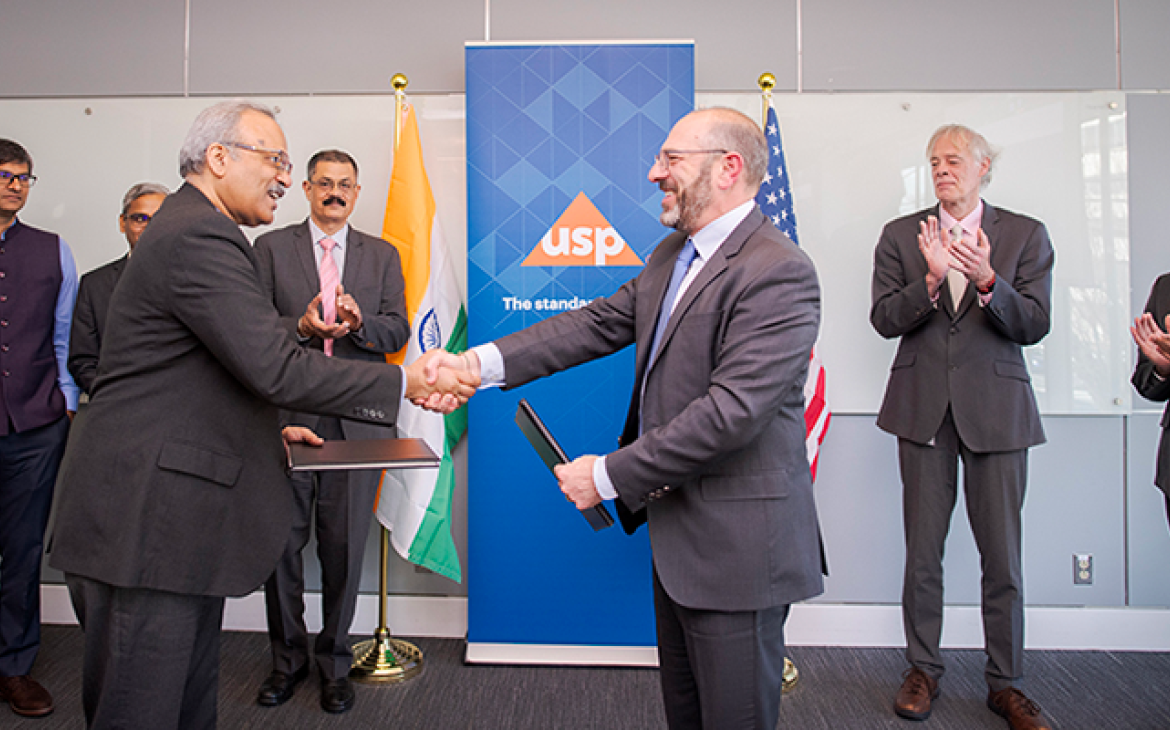
When a problem puts millions of lives at risk, costs economies billions of dollars and undermines decades of hard-earned health progress, it deserves prompt and strategic attention. I’m describing the consequences of poor-quality medicines – a worldwide problem that deserves worldwide attention. Yet in many public health policy discussions, it receives little, if any, consideration. Now is the time for us to prioritize the issue of medicines quality.
What do I mean by “medicines quality”?
Imagine you are at a grocery store, picking out a few apples for your kids’ lunches. You probably look for bruises and feel for soft spots. Because you can’t cut into it while you are standing in the middle of the produce section, you trust that your simple “quality control checks” will help you avoid selecting sour or mealy apples.
Now think about when you fill a prescription at the pharmacy. You likely trust that the medicine is what the package says it is, without questioning if it has the right amount of the active ingredient or wondering if it contains harmful contaminants. This trust may be based on assumptions you might not even realized you are making – such as assuming that numerous quality control checks have been performed during the medicine’s manufacture, shipping and storage to assure its quality. And that may be ok. Because in many parts of the world, including the United States, strong regulatory systems, rigorous standards-setting organizations, responsible manufacturers, and well-trained health professionals have assured the quality of medicines. But in many parts of the world, this simply isn’t that case – and people are harmed because of it.
In fact, according to the World Health Organization (WHO), one in ten medicines sold in low- and middle- income countries are poor quality. In some cases the medicine may be manufactured properly, but might degrade after exposure to extreme temperatures or being left in a storage facility too long. In other cases, the medicine may have been intentionally altered or faked. And while the drug might look right, it actually contains substances such as chalk or flour (or worse) that won’t treat the intended condition and may be poisonous.
Impact of poor-quality medicines
The proliferation of poor-quality medicines has alarming implications for global health. When medicines do not work as expected – or at all – they can:
- Delay appropriate treatment, make people sicker, and lead to preventable deaths
- Waste tens of billions of dollars each year. Approximately $30 billion is spent on medicines that do not meet quality standards, an estimate that does not account for the larger economic impact of poor-quality medicines, such as from additional treatments or lost wages
- Contribute to the growth of antimicrobial resistance (AMR) because pathogens may mutate into a resistant strain after patients receive substandard doses of medicine
Poor-quality medicine is a global health challenge and its consequences affect all of us. For instance, in the United States, more than 2 million people each year are infected with drug-resistant microbes, resulting in 23,000 deaths. Because AMR is a borderless threat, we need to respond accordingly and recognize that medicines quality must be a priority worldwide.
Bringing quality to the forefront
If a medicine is poor-quality, then it is not really a medicine. We must face the issue head-on, driving research and awareness about the importance of guaranteeing safe, quality medicines in every country. Investments in public health will be more efficient and effective when policy makers consider the connection between medicines quality and positive public health outcomes, and direct investments to assure the quality of medicines.
As the Director of the Quality Institute, I lead USP’s research division devoted to generating rigorous evidence about the value of quality medicines as a critical component of public health. With our findings, we aim to encourage open discussion, inform global health decision makers, and encourage investments in the strategic approaches needed to assure quality medicine around the world.
Thankfully, we aren’t alone in taking on this issue. In fact, this past fall I attended the first-ever Medicine Quality and Public Health (MQPH) Conference, held at Keble College in Oxford. It was heartening to join leaders in health policy, as well as researchers, pharmacists, legal advocates, national regulators, and representatives of other international organizations from around the world, to hear their perspectives and discuss ways we can address this issue. I was honored to participate in a panel discussion on AMR, where I stressed the importance of research to identify where resources should be devoted to make the most impact.
Investing in research as part of the solution
The Quality Institute partners with leading academic institutions to establish research fellowships. Our fellows conduct research over one- or two-year timeframes, and report their results throughout, not just at the end of their projects, so that our findings strategically inform public health decision-making in real time.
Since 2017, we have prioritized research that will help explain the link between poor-quality medicines and the rise of resistant microbes. The preliminary results are promising; one of our fellows presented at MQPH in Oxford, describing his experiments that show poor-quality medicines drive resistance in Malaria drugs in a similar way as poor adherence. This is a good example about how our research might change the conversation in policy spheres – usually only adherence and access to medicines are discussed as ways to effectively combat malaria.
In 2018, we began to focus new fellowships on how the quality of excipients, or the “inactive ingredients” in medicine, impacts the quality of finished medicines. We know that excipients serve many functions, such as ensuring the active pharmaceutical ingredient reaches the right part of the body or making a pill palatable or easier to swallow. Until recently, excipients were considered inert or inactive, but that view is changing. In our next wave of research, we will explore how excipients could be contributing to poor-quality medicines, as well as how they might be used to help maintain medicines quality.
What’s next?
As we move into 2019, the Quality Institute will begin to explore global procurement practices and how they impact quality. There are a wide variety of ways that medicines are purchased from manufacturers and distributed to patients, and some research has suggested that the emphasis on lowest-cost medicines may create incentives for unscrupulous manufacturers to cut corners on quality. Our research will help inform manufacturers about effective ways to ensure that they produce quality medicines that maintain their quality until they get to patients.
In addition, we expect to announce new academic partnerships and recruit new fellows in 2019. And in the next several months our first fellows will begin to formally report their findings in academic journals. With those published reports in hand, and working with my USP colleagues, I will help promote the application of our research in ways that improve access to quality-assured medicines. I look forward to sharing these exciting milestones with you, and to working together to support medicines quality – because we all deserve medicines we can trust.


